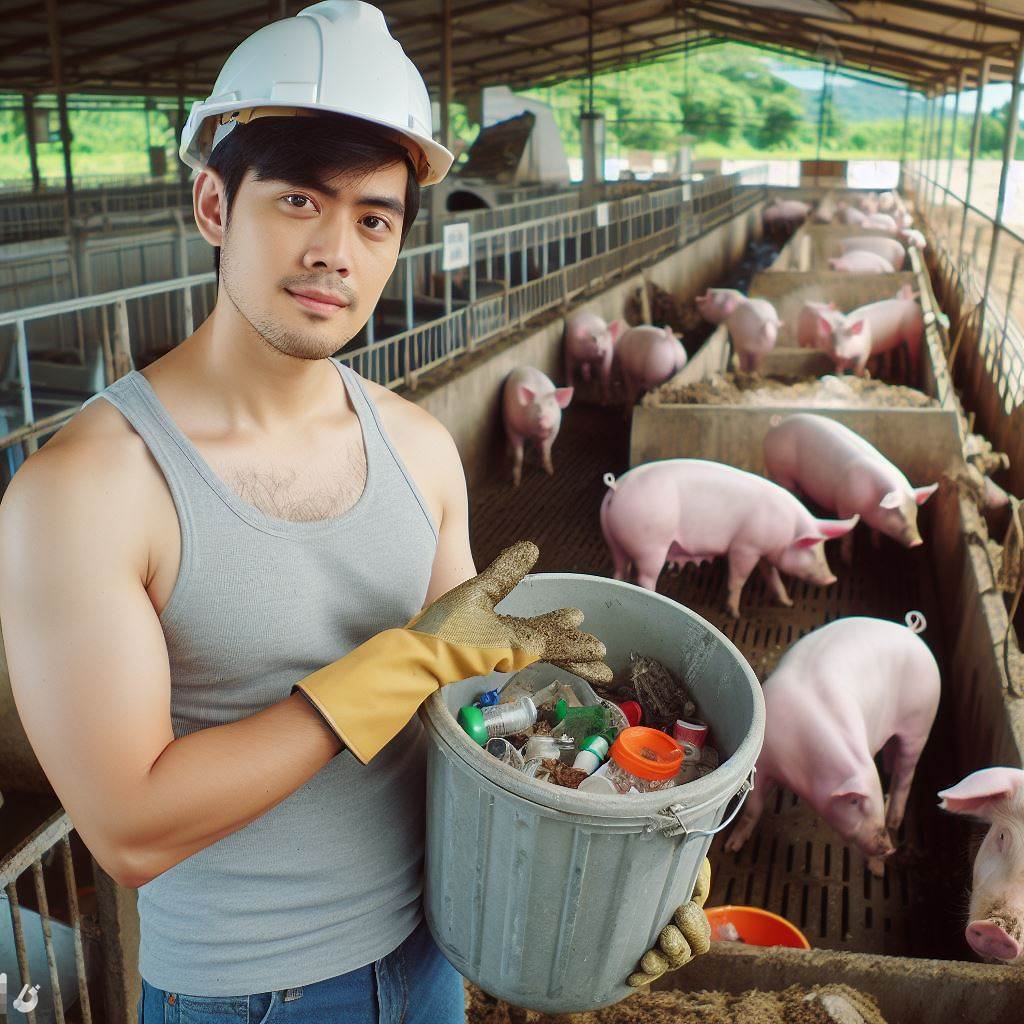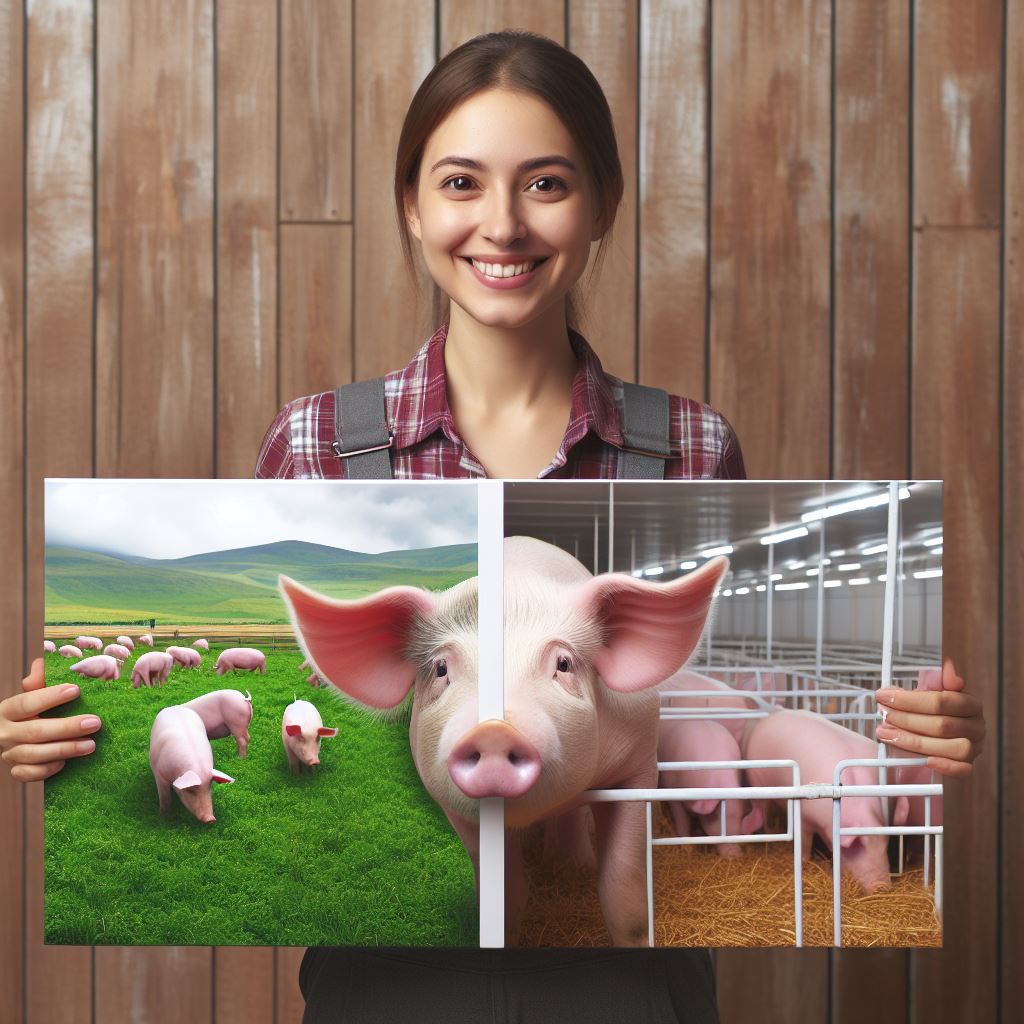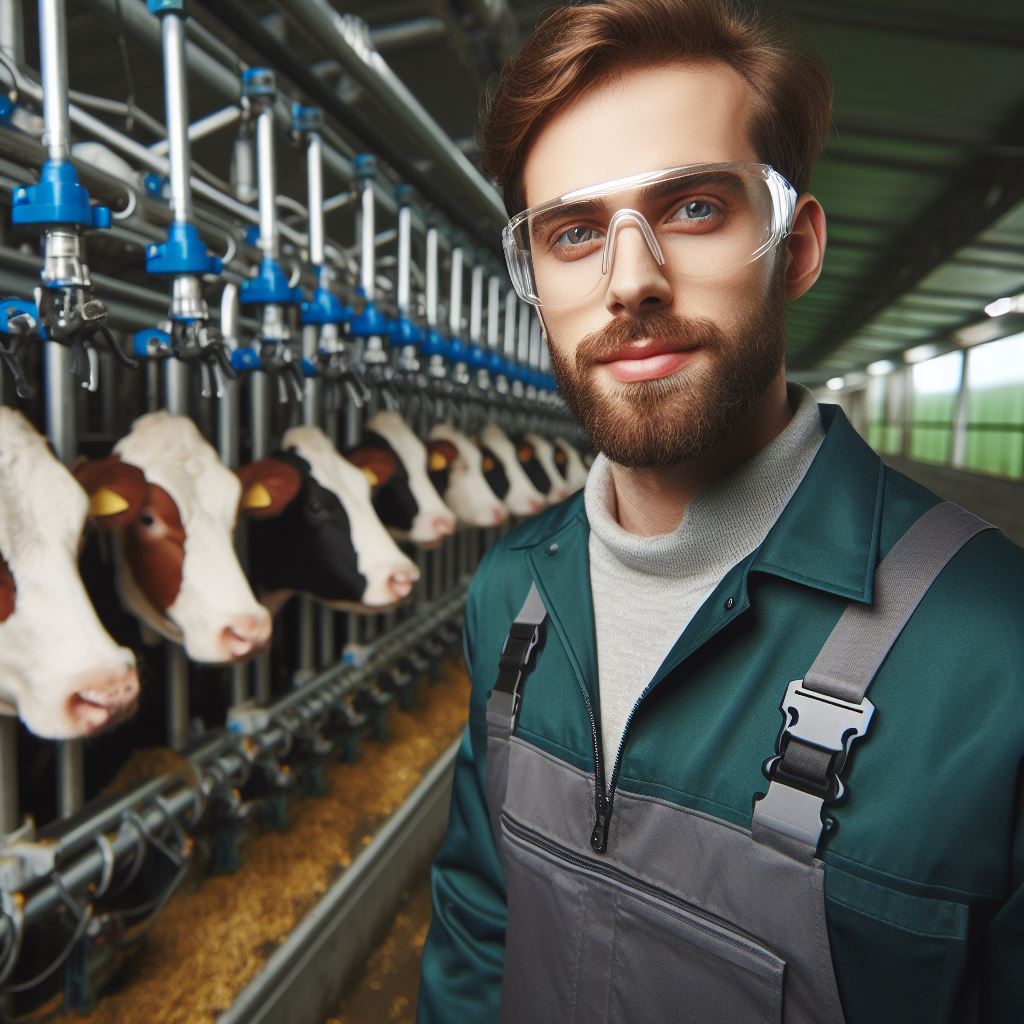Introduction
Ensuring the health and well-being of pigs is paramount in modern farming practices.
Biosecurity serves as the cornerstone, actively preventing and managing potential threats to pig farms.
This section explores the crucial importance of implementing robust biosecurity measures.
As we embark on this discussion, the purpose of this blog post becomes clear.
We aim to empower farmers with essential knowledge, providing insights into the key elements of pig farm biosecurity.
By understanding its significance and practical application, farmers can enhance their practices, creating a resilient and thriving environment for their pig populations.
Join us on this journey as we unravel the essentials of pig farm biosecurity, equipping farmers with the tools they need for success in pig farming while ensuring the health and sustainability of their operations.
Definition and Explanation of Pig Farm Biosecurity
Definition of Biosecurity
Biosecurity is a set of measures and protocols implemented to prevent the entry and spread of diseases within a pig farm.
It aims to protect the health and welfare of the pigs and the overall productivity of the farm.
Biosecurity measures include strict hygiene practices, controlled access to the farm, and monitoring and surveillance for early disease detection.
These protocols are crucial in minimizing the risk of disease introduction and transmission within the pig population.
Importance of Biosecurity in Pig Farming
Disease Prevention
One of the primary reasons why biosecurity is essential in pig farming is to prevent the introduction and spread of diseases.
Pigs are susceptible to various infectious diseases, including African Swine Fever (ASF) and Porcine Epidemic Diarrhea (PED).
Strict biosecurity measures act as a barrier to these diseases and protect the entire pig population.
Economic Impact
Disease outbreaks can have severe economic repercussions on pig farms.
Transform Your Agribusiness
Unlock your farm's potential with expert advice tailored to your needs. Get actionable steps that drive real results.
Get StartedThe financial losses incurred from mortality, reduced production, and trade restrictions can be devastating.
By implementing effective biosecurity measures, farmers can safeguard their investments and ensure long-term profitability.
Animal Welfare
Good biosecurity practices contribute to the overall health and welfare of the pigs.
By minimizing disease occurrence, pigs can lead healthier lives, free from unnecessary suffering and discomfort.
This is crucial for ethical and responsible pig farming.
Public Health
Certain pig diseases, such as swine influenza, have zoonotic potential, meaning they can be transmitted from animals to humans.
Biosecurity measures protect farm workers and nearby communities by preventing the spread of zoonotic diseases.
Compliance with Regulations
Many countries have strict biosecurity regulations in place to prevent disease transmission and maintain food safety standards.
By adhering to these regulations, pig farmers can demonstrate their commitment to producing safe and wholesome pork products.
Reputation and Consumer Confidence
Consumers are increasingly concerned about the safety and quality of the food they consume.
Pig farms with robust biosecurity programs gain trust and confidence from consumers, enhancing their reputation in the market.
This can translate into increased demand and better business opportunities.
Risk Management
Biosecurity acts as a risk management tool, allowing farmers to proactively identify and mitigate potential disease threats.
By implementing preventive measures, such as vaccination programs and quarantine protocols, farmers can significantly reduce the risk of disease outbreaks.
Industry Sustainability
Biosecurity is crucial for maintaining the sustainability of the pig farming industry.
By preventing and controlling diseases, farmers can ensure the continuity of their operations, without relying heavily on antibiotics and other medical interventions.
This contributes to the long-term viability of the industry and its ability to meet global pork demands.
Therefore, biosecurity is of utmost importance in pig farming.
It plays a vital role in disease prevention, economic stability, animal welfare, public health, and industry sustainability.
By implementing effective biosecurity measures, pig farmers can safeguard their investments, protect animal health, and maintain consumer confidence in their products.
Read: Pig Behavior: Understanding Your Herd
Key components of pig farm biosecurity
Isolation and quarantine measures
Importance of isolating new pigs
Isolating new pigs is crucial in preventing the introduction and spread of diseases on a pig farm.
By separating them from the existing herd, the risk of disease transmission can be minimized.
This practice also allows for proper monitoring and evaluation of the health status of the new arrivals.
Showcase Your Farming Business
Publish your professional farming services profile on our blog for a one-time fee of $200 and reach a dedicated audience of farmers and agribusiness owners.
Publish Your ProfileIsolation provides a controlled and restricted environment where newly introduced pigs can be observed for any signs of disease.
It is essential to keep them in separate pens or buildings away from the main herd to ensure that any disease they may carry does not spread to healthy pigs.
Isolation reduces the chances of virus or bacteria transmission and allows time for early detection of any disease.
Newly arrived pigs should be isolated for a minimum of 30 days.
This duration is necessary to monitor their health conditions and identify any potential diseases they may have brought with them.
During this period, close attention should be given to their behavior, appetite, fecal consistency, and overall well-being.
Regular veterinary check-ups and diagnostic tests can aid in early disease detection.
Quarantine process and duration
Quarantine, a crucial step in biosecurity, involves the implementation of strict measures to confine and monitor animals suspected of carrying diseases.
It is essential to establish a separate quarantine area where new pigs can be closely observed and tested before joining the main herd.
The quarantine duration should last a minimum of 30 days or as recommended by a veterinarian.
During this time, new pigs should undergo routine health examinations and diagnostic tests.
These tests may include serological and molecular assays to detect specific diseases like African Swine Fever (ASF) or Porcine Epidemic Diarrhea (PED).
Quarantine should not be lifted until test results confirm the absence of diseases.
Quarantine facilities should be equipped with proper biosecurity measures to minimize the risk of disease transmission.
These include separate tools, equipment, and protective clothing, which should be used solely within the quarantine area.
Personnel entering the quarantine zone should follow strict hygiene protocols, such as washing hands and using disinfectants, to prevent disease spread.
Precautions must also be taken when handling waste or manure from the quarantined area.
Proper disposal methods should be followed, such as composting or disinfection, to prevent the spread of pathogens.
Attention should also be given to maintaining strict biosecurity controls when transporting animals to and from the quarantine area.
Most importantly, isolation and quarantine measures are key components of pig farm biosecurity.
By implementing them effectively, pig farmers can protect their herds from the introduction and spread of diseases.
Isolation allows for the careful monitoring of new pigs, while quarantine provides a controlled environment for testing and evaluating their health.
Following proper procedures and taking necessary precautions will contribute to maintaining a healthy and disease-free pig population.
Read: Layer vs. Broiler: Choosing Your Poultry Path
Hygiene Practices
A crucial aspect of maintaining a biosecure pig farm is implementing effective hygiene practices.
Proper cleaning, disinfection protocols, sanitation of equipment and facilities, and maintaining personal hygiene for farm workers are essential to prevent disease outbreaks and ensure the health and welfare of the pigs.
In this section, we will delve deeper into each aspect in detail.
Cleaning and Disinfection Protocols
- Regularly clean all areas and surfaces using appropriate detergents and disinfectants.
- Focus on high-risk areas such as farrowing rooms, nurseries, and medical facilities.
- Ensure proper cleaning of equipment, including removing organic matter before disinfection.
- Follow strict protocols for handling and storing disinfectants to maintain their effectiveness.
- Regularly evaluate and update cleaning and disinfection protocols based on scientific research and farm-specific needs.
Sanitation of Equipment and Facilities
- Incorporate a routine sanitation schedule for all equipment and farm facilities.
- Thoroughly clean and disinfect equipment after each use to prevent cross-contamination.
- Pay extra attention to shared equipment, such as feeders, waterers, and handling tools.
- Ensure proper maintenance of biosecurity measures in pest control to prevent infestations.
- Regularly check and repair any damaged areas that could compromise biosecurity.
Personal Hygiene for Farm Workers
- Promote a culture of strict personal hygiene among all farm workers.
- Emphasize the importance of handwashing before and after handling pigs and entering different areas.
- Provide appropriate personal protective equipment (PPE) and ensure its proper use.
- Establish protocols for showering and changing clothes before entering restricted areas.
- Implement training programs and regular reminders to reinforce personal hygiene practices.
Practicing proper hygiene in pig farms is paramount to prevent the introduction and spread of diseases.
By following cleaning and disinfection protocols, maintaining sanitation of equipment and facilities, and promoting personal hygiene for farm workers, the risk of disease transmission can be significantly reduced.
These practices play a crucial role in safeguarding pig health and ensuring the sustainability of the pig farming industry.
Read: Poultry Management: Key Techniques

Disease monitoring and prevention
A pig farm’s biosecurity measures should include robust disease monitoring and prevention protocols.
By regularly assessing the health of pigs, implementing vaccination programs, and consistently monitoring and testing for diseases, farmers can effectively safeguard their herds.
Regular health checks for pigs
Conducting regular health checks for pigs is crucial in maintaining a disease-free environment.
These checks should be carried out by trained personnel who can detect signs of illness and take appropriate actions.
During health checks, veterinarians or farm staff should assess pigs for any abnormalities such as coughing, sneezing, lameness, or changes in behavior.
Any potential issues should be promptly addressed to prevent the spread of disease.
Furthermore, regular health checks allow for early detection of diseases, enabling prompt treatment and containment measures.
Vaccination programs
Implementing a comprehensive vaccination program is essential in preventing the occurrence and spread of diseases among pigs.
Vaccines can effectively protect pigs against specific pathogens, ensuring herd health and productivity.
Showcase Your Farming Business
Publish your professional farming services profile on our blog for a one-time fee of $200 and reach a dedicated audience of farmers and agribusiness owners.
Publish Your ProfileConsulting with a veterinarian is crucial for developing an appropriate vaccination plan tailored to the farm’s specific needs.
Vaccines should be administered according to recommended schedules and adjusted based on the prevalence of diseases in the area.
Vaccination programs play a vital role in reducing the risk of disease outbreaks, minimizing economic losses, and maintaining the overall welfare of the pigs.
Monitoring and testing for diseases
Importance of early disease detection
Early disease detection is vital in preventing the spread and severity of diseases within a pig farm.
Regular monitoring allows for prompt identification of potential issues, enabling swift actions to be taken.
Farmers should be vigilant in observing pigs for any signs of illness and should immediately report any abnormalities to the farm’s veterinarian.
Early detection can help minimize the impact of diseases on both individual pigs and the entire herd.
Appropriate testing methods
To ensure effective disease monitoring, appropriate testing methods should be selected.
These methods may include laboratory tests, on-site diagnostic tools, or collaboration with veterinary hospitals or diagnostic laboratories.
Testing allows for the identification and confirmation of diseases, helping farmers make informed decisions regarding treatment, control measures, and biosecurity improvements.
It is important to consult with experts to determine the most suitable testing methods based on the prevalence of diseases in the region and the farm’s specific requirements.
In essence, disease monitoring and prevention are fundamental aspects of pig farm biosecurity.
By conducting regular health checks, implementing vaccination programs, and monitoring and testing for diseases, farmers can maintain a healthy and productive herd, reducing the risk of disease outbreaks and economic losses.
Read: Goat Rearing: Tips for Best Results
Pest and predator control
Measures to prevent the entry of pests and predators
- Implement strict biosecurity protocols to minimize the risk of pest and predator introduction.
- Install secure fencing and gates to create physical barriers and prevent unauthorized entry.
- Regularly inspect and repair any gaps or openings in buildings, walls, and fences.
- Use pest-proof material for construction and ensure proper sealing of entry points.
- Implement a double-entry system to control access, such as a buffer zone with restricted vehicle entry.
- Consider employing electronic surveillance systems to monitor access points and detect any unauthorized entries.
- Develop a pest and predator prevention plan in collaboration with biosecurity experts.
- Train staff on essential biosecurity practices, emphasizing the importance of pest and predator control.
- Monitor and restrict movement of vehicles and equipment to minimize the risk of pest and predator transportation.
- Regularly clean and disinfect vehicles and equipment coming in contact with external environments.
- Keep surrounding areas clean and free of potential pest habitats, such as rubbish or tall grass.
Rodent control strategies
- Implement a comprehensive rodent control program to reduce the risk of disease transmission.
- Identify and seal any cracks or gaps in buildings where rodents may enter.
- Install rodent-proofing measures on doors, windows, and ventilation openings.
- Place traps and bait stations strategically to catch and eliminate rodents.
- Regularly inspect and clean traps, replacing bait as needed.
- Implement a proactive monitoring system to identify rodent activity and take immediate action.
- Use rodenticides as a last resort, following strict safety guidelines to minimize risks to non-target species.
- Implement strict waste management protocols to avoid attracting rodents with food sources.
- Store feed and other organic material in rodent-proof containers.
- Regularly clean and disinfect feed storage areas to reduce the risk of contamination.
- Maintain a clean and organized environment, removing potential rodent hiding places.
Ensuring biosecurity on a pig farm is vital for disease prevention and animal welfare.
Robust pest and predator control measures are imperative to safeguard the farm environment.
This includes securing fencing, gates, and employing electronic surveillance, while regular inspections and immediate repairs using pest-resistant materials are essential.
Collaboration with biosecurity experts aids in developing a comprehensive prevention plan, and staff training ensures strict adherence to biosecurity practices.
Monitoring vehicle movement, coupled with thorough cleaning and disinfection, reduces the risk of pest and predator introduction.
Combatting rodents, known disease vectors, involves strategies such as identifying entry points, using traps and bait stations, with rodenticides as a last resort.
Proper waste management, storing feed in rodent-proof containers, and maintaining a clean environment are crucial practices.
Implementing these measures significantly reduces the risk of disease transmission, ensuring the health and safety of pig farm animals.
Visitor and Vehicle Management
As part of a comprehensive biosecurity plan, visitor and vehicle management plays a crucial role in preventing disease introduction and transmission on a pig farm.
By implementing restrictions, protocols, and thorough monitoring, farm owners can significantly reduce the risk of disease outbreaks and ensure the health and safety of their animals.
Restrictions and protocols for farm visitors
When it comes to farm visitors, it is important to establish and communicate strict guidelines to minimize the potential risks.
All visitors should be required to sign in and provide information about their recent contact with animals.
This allows farm owners to assess the potential biosecurity risks associated with each visitor.
To further reduce the risk of disease transmission, clear instructions on proper hygiene practices and the use of protective clothing should be provided to visitors.
Designated visitor areas, where interaction with pigs is limited, should also be established to minimize direct contact between animals and visitors.
Regular communication with visitors is essential to keep them informed about any current disease outbreaks or biosecurity measures in place.
Educating visitors on the importance of biosecurity and their role in preventing disease spread can further enhance farm biosecurity.
Monitoring and control of vehicles entering the farm
Another critical aspect of farm biosecurity is monitoring and controlling vehicles entering the farm premises.
Developing a system to track all vehicles entering and exiting the farm can help identify potential sources of disease introduction.
All vehicles should be thoroughly cleaned and disinfected before entering the farm.
Installing signage at the farm entrance that reminds drivers to adhere to biosecurity protocols serves as a constant reminder of their responsibilities.
Regular inspections of vehicles entering the farm should be conducted to ensure compliance with biosecurity standards.
Detailed records of all vehicles that enter the farm should be kept, including information about the purpose and origin of each vehicle.
To further enhance farm biosecurity, a strict policy of allowing only essential vehicles on the farm premises should be implemented.
This reduces the number of potential disease carriers entering the farm and minimizes the risk of disease transmission.
In fact, visitor and vehicle management is an essential component of pig farm biosecurity.
Showcase Your Farming Business
Publish your professional farming services profile on our blog for a one-time fee of $200 and reach a dedicated audience of farmers and agribusiness owners.
Publish Your ProfileBy implementing restrictions and protocols for farm visitors, and closely monitoring and controlling vehicles entering the farm, farm owners can significantly reduce the risk of disease introduction and transmission.
This, in turn, helps safeguard the health and welfare of their animals and ensures the overall success and sustainability of the farm operation.
Employee education and training
Importance of educating the workforce on biosecurity protocols
Biosecurity protocols are crucial in maintaining the health and safety of pig farms.
One key aspect of this is educating the workforce.
Proper training ensures that employees understand the importance of adhering to biosecurity measures.
By educating the workforce, farms can minimize the risk of disease outbreaks and protect their investment.
It is vital for employees to comprehend how their actions can impact the biosecurity of the farm.
Training programs create awareness about potential risks and teach employees how to mitigate them.
With proper education, employees become a proactive line of defense against disease introduction and spread.
Training programs for farm employees
Training programs play a pivotal role in maintaining pig farm biosecurity and preventing diseases.
Comprehensive sessions should cover various aspects:
Educate employees on essential hygiene practices, emphasizing handwashing and proper use of protective clothing.
Include procedures for handling sick animals and identifying disease signs.
Stress the significance of proper waste management to prevent contamination.
Train employees on vehicle and equipment hygiene, crucial for preventing disease introduction from other farms.
Emphasize the importance of restricted visitor access and quarantine procedures for newly introduced animals.
Provide training on detecting and reporting unusual pig behavior or symptoms promptly.
Ensure regular updates and refresher courses to keep employees informed about best practices.
Combine theoretical knowledge with practical training to reinforce learning.
Conduct mock drills to allow employees to practice emergency response procedures and strengthen biosecurity measures.
Involve employees in developing and reviewing biosecurity protocols to foster a sense of ownership.
Encourage employees to ask questions and provide feedback for continuous improvement.
Motivate participation through incentives like rewards and recognition.
Farm managers should regularly assess the effectiveness of training programs and make necessary adjustments.
Investing in education and training demonstrates a commitment to maintaining high biosecurity standards, ultimately safeguarding pig and farm health.
Continuous improvement in training programs helps farms stay proactive in mitigating biosecurity risks and ensures the industry’s long-term sustainability.
Prioritizing employee education is key to securing the future of pig farming.
Emergency Preparedness
Response Plans for Disease Outbreaks
Emergency preparedness is crucial for pig farms to minimize the impact of disease outbreaks.
Having a well-defined response plan allows for an efficient and coordinated approach in managing such crises.
It is essential to involve all relevant personnel and train them adequately to ensure a smooth execution of the response plan.
When facing a disease outbreak, early detection and isolation of sick pigs are vital to prevent the spread of the infection.
Implementing protocols for swift identification and separation can help contain the outbreak and minimize its impact on the overall herd.
Adequate housing facilities with proper ventilation and temperature control should be provided for isolated pigs to ensure their well-being.
Consulting with a veterinarian plays a crucial role in developing appropriate treatment plans for sick pigs.
Timely administration of medications and treatments as prescribed by the veterinarian can greatly improve the chances of recovery.
Regular monitoring and evaluation of the pigs’ response to treatment enable adjustments to be made if necessary.
Protocols for Isolating and Treating Sick Pigs
Maintaining detailed records of each pig’s condition, treatment, and recovery progress is essential for future reference and to track the effectiveness of different treatments.
These records also aid in identifying patterns and trends that may assist in preventing future disease outbreaks.
Strict adherence to biosecurity measures is crucial when handling or disposing of contaminated materials from sick pigs.
This includes proper waste management, disinfection, and sanitization of all areas and equipment used in the treatment or care of sick animals.
Showcase Your Farming Business
Publish your professional farming services profile on our blog for a one-time fee of $200 and reach a dedicated audience of farmers and agribusiness owners.
Publish Your ProfileImplementing biosecurity measures for personnel involved in treating sick pigs helps prevent the spread of diseases to other animals or locations.
By prioritizing emergency preparedness, pig farms can effectively respond to disease outbreaks, minimize potential losses, and protect the overall health of their herds.
Regularly reviewing and updating response plans, conducting simulated exercises, and collaborating with local veterinary authorities contribute to a proactive approach in handling emergencies.
The wellbeing and biosecurity of pigs are at the heart of these measures, ensuring the sustainability of pig farming operations.
Conclusion
Recap of essential pig farm biosecurity measures
- Implement strict entry and exit protocols to control the movement of people and vehicles.
- Ensure proper hand hygiene and the use of appropriate protective clothing and equipment.
- Implement effective pest and vector control measures to prevent disease transmission.
- Segregate and quarantine new animals to prevent the introduction of diseases to the farm.
- Establish proper waste management systems to reduce the risk of disease transmission.
- Regularly monitor and maintain biosecurity protocols to ensure their effectiveness.
Importance of adhering to biosecurity protocols for the sustainability of pig farming
Adhering to biosecurity protocols is crucial to prevent the introduction and spread of diseases in pig farms.
Disease outbreaks can have disastrous consequences, including high mortality rates, reduced production efficiency, and economic losses.
By implementing and consistently following biosecurity measures, farmers can protect their herds from diseases, maintain the health and welfare of their animals, and secure the long-term sustainability of their businesses.
Biosecurity protocols not only protect the individual farm but also contribute to the overall biosecurity of the pig farming industry.
Disease prevention and control at the farm level help maintain a healthy population of pigs in the industry, which, in turn, ensures a stable supply of pork for consumers.
Additionally, by preventing the spread of diseases, biosecurity measures contribute to the reduction of antimicrobial use and the development of antimicrobial resistance.
Proper pig farm biosecurity is essential for protecting the health and productivity of pig herds, safeguarding the industry’s sustainability, and promoting public health by ensuring a safe and stable pork supply.
It is crucial for farmers to understand and implement effective biosecurity measures to prevent disease outbreaks and secure the long-term success of their pig farming operations.




